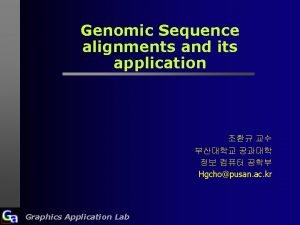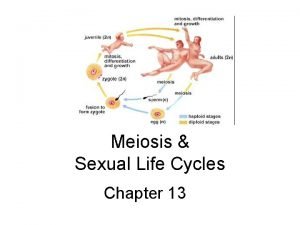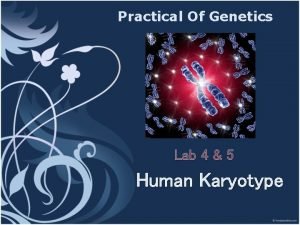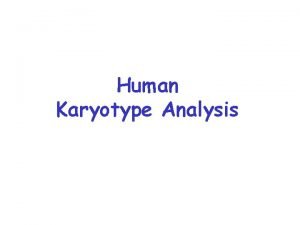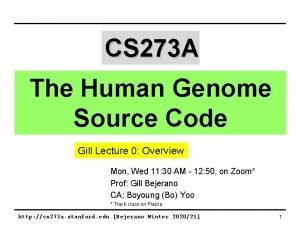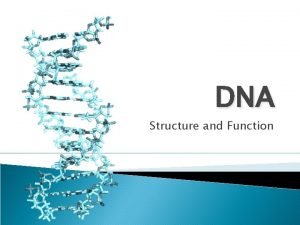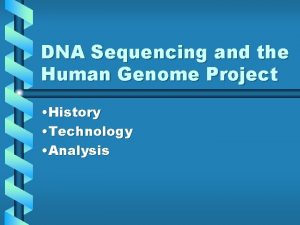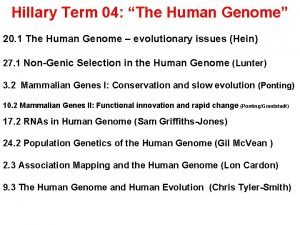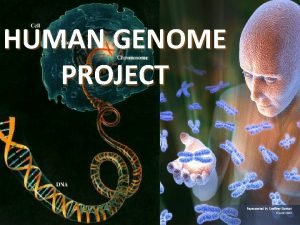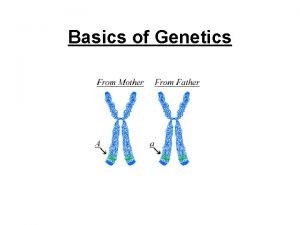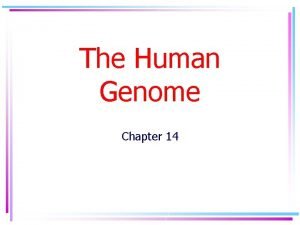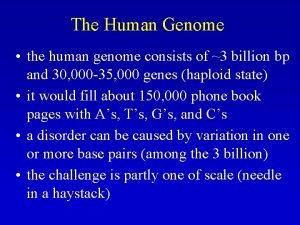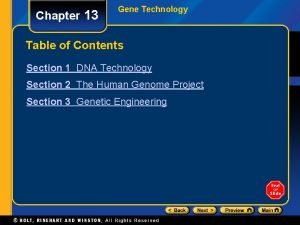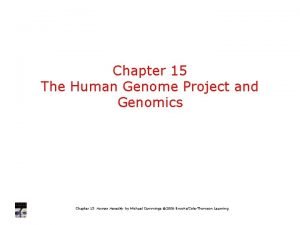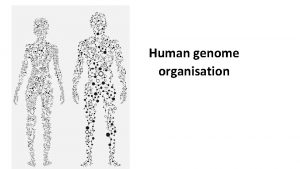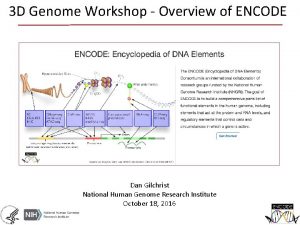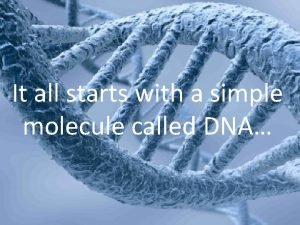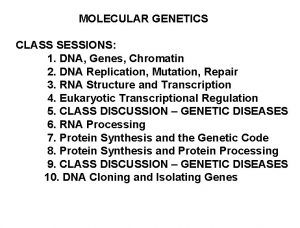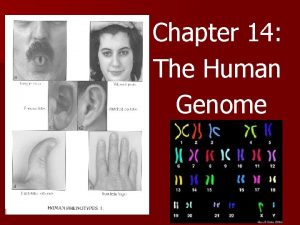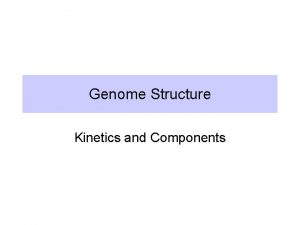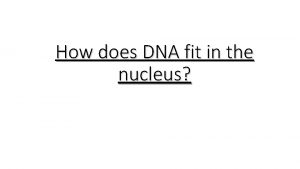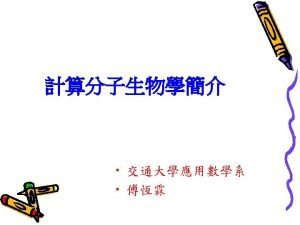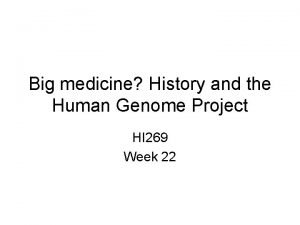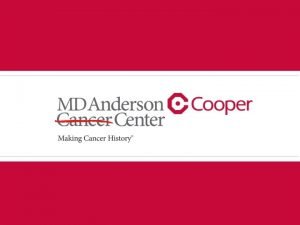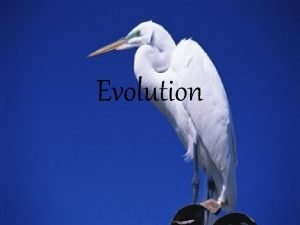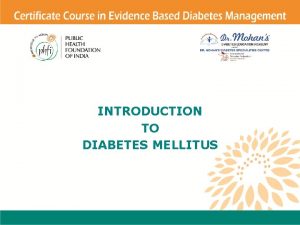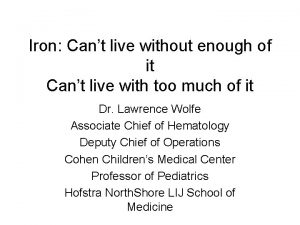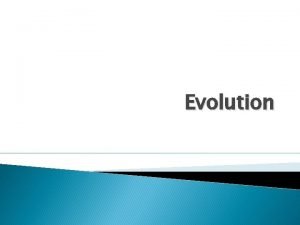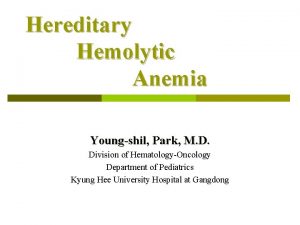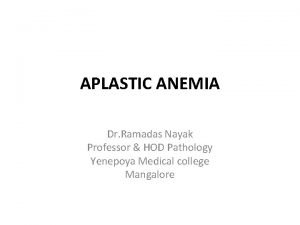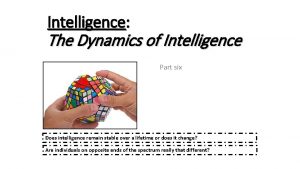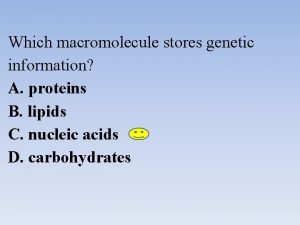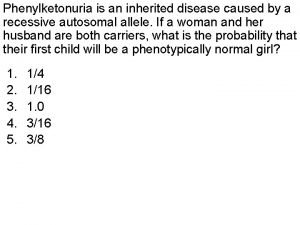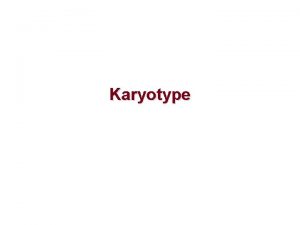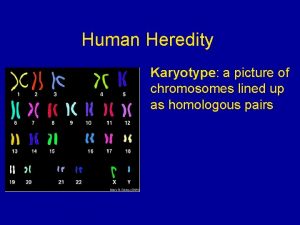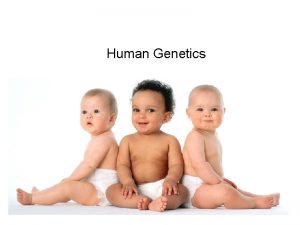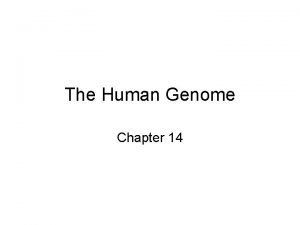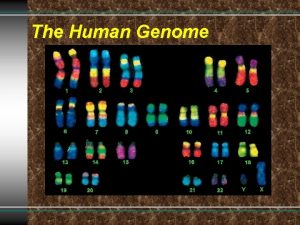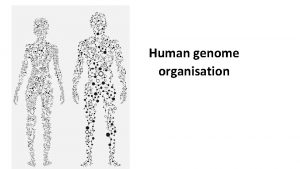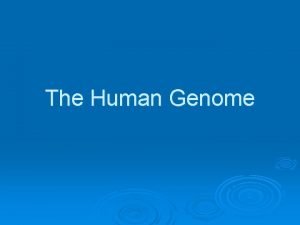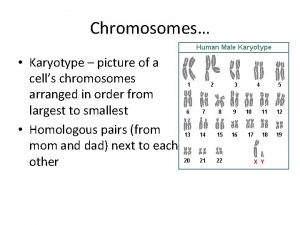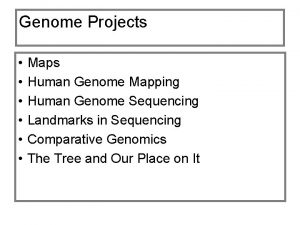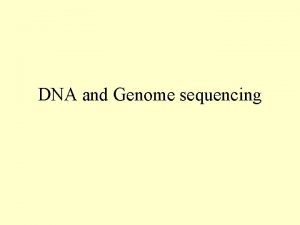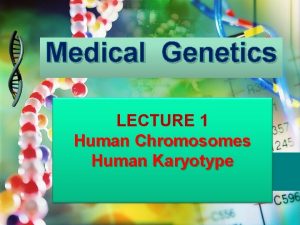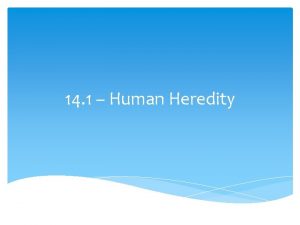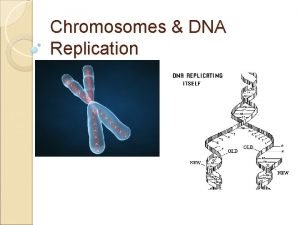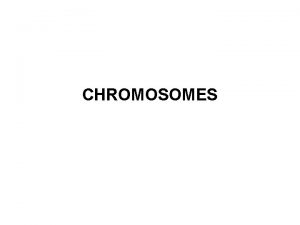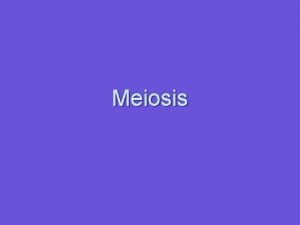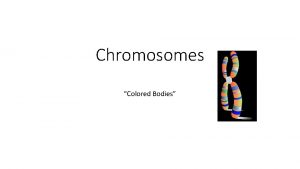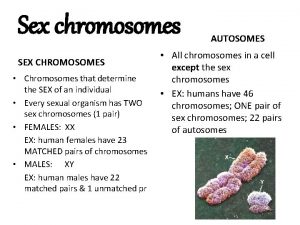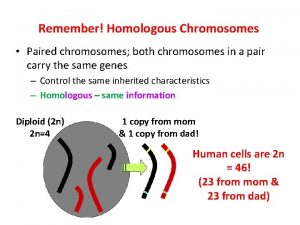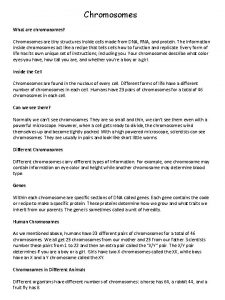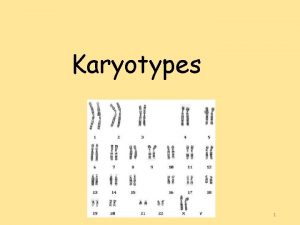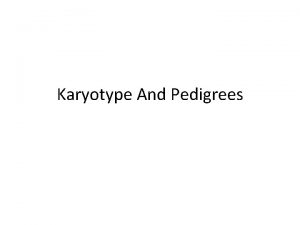THE HUMAN GENOME HUMAN HEREDITARY HUMAN CHROMOSOMES KARYOTYPE






































- Slides: 38

THE HUMAN GENOME HUMAN HEREDITARY

HUMAN CHROMOSOMES • KARYOTYPE: PICTURE ARRANGEMENT OF CHROMOSOMES • CHROMSOMES ARRANGED FROM LONGEST TO SHORTEST PAIRS • FIRST 22 PAIRS: AUTOSOMES • PAIR 23 SEX CHROMOSOMES (X AND Y) • XX = FEMALE/XY = MALE

NORMAL KARYOTYPE

HUMAN TRAITS • FOLLOW MENDELIAN GENETICS • PEDIGREE: RELATIONSHIPS W/I A FAMILY • SQUARES: MALES • CIRCLES: FEMALES • SOLIDS: HAS TRAITS • HALF-SHADED: CARRIER • EMPTY: DOES NOT HAVE TRAIT/NOT CARRIER

HUMAN GENES • CODOMINANT TRAITS: 2 DOMINANT ALLELES W/ BOTH BEING EXPRESSED • BLOOD GROUPS: ABO ALLELES • IA AND IB BOTH DOMINANT. • i IS RECESSIVE. • A AND B ARE ANTIGENS ON BLOOD CELL

AUTOSOMAL RECESSIVE ALLELES • PKU (PHENYLKETONURIA): LACK ENZYME TO BREAK DOWN AMINO ACID PHENYLALANINE (MILK AND OTHER FOODS) • CHROMOSOME 12

AUTOSOMAL RECESSIVE DISORDERS • 1 IN 15, 000 U. S. BIRTHS • PREVALENT IN WHITES AND ASIANS • LEFT UNTREATED RESULTS IN SEVERE MR

AUTOSOMAL RECESSIVE DISORDERS • TAY-SACHS DISEASE: BREAKDOWN OF NERVOUS SYSTEM AND DEATH W/I FIRST YEARS • JEWISH POPULATION OF CENTRAL/EASTERN EUROPEON DESCENT

TAY-SACHS • CHERRY RED SPOT IN EYE RETINA • LIPID DEPOSITS IN BRAIN NEURONS

AUTOSOMAL RECESSIVE DISORDERS • CYSTIC FIBROSIS: EXCESS MUCUS IN LUNGS, DIGESTIVE TRACT, LIVER • DAMAGED LUNG TISSUE

AUTOSOMAL DOMINANT ALLELES • ACHONDROPLASIA: FORM OF DWARFISM • SHORT LIMBS, HEAD PROPORTION TO BODY

AUTOSOMAL DOMINANT DISORDERS • HUNTINGTON’S DISEASE • ONSET IN 30’S AND OLDER • PROGRESSIVE LOSS OF MUSCLE CONTROL AND MENTAL FUNCTION

MUTATIONS FROM GENES TO MOLECULES • CYSTIC FIBROSIS: CHROMOSOME 7 • DELETION OF 3 BASES WHICH DELETES AMINO ACID PHENYLALANINE • CHORIDE IONS NOT ABLE TO BE TRANSPORTED ACROSS MEMBRANES

SICKLE CELL ANEMIA • ABNORMAL RED BLOOD CELLS • ONE BASE IS SUBSTITUTED • AMINO ACID VALINE FOR GLUTAMIC ACID • DAMAGES TISSUES AND ORGANS, PHYSICAL WEAKNESS, EVEN DEATH

X-CHROMOSOME INACTIVATION • ONE X IN FEMALES IS “TURNED OFF” • BARR BODY IN THE NUCLEUS • CALICO CATS: X THAT IS TURNED OFF VARIES THROUGHOUT BODY

Mutations – changes in the genetic material – oops! Gene Chromosomal mutations • Changes to the • Point number or mutations – structure of a changes in a chromosome one or two nucleotides. – Deletions – Substitution – Frame shift mutations • Insertions – Duplications – Inversions – Translocations

Pedigree Charts • Shows patterns of inheritance of human traits in a family. • Used by genetic counselors to determine genotypes

Representative symbols • Circles – female • Squares – male • Colored in – affected • Blank – not affected • Horizontal lines – marriage • Vertical lines – offspring • Split lines – twins • Slash through shape - dead

Genetic Disorders • Disease caused by an abnormality in DNA • Many types • Small change or entire chromosomes could have be added or deleted • Could have an allele for the disorder but never expresses it - carrier • Some are expressed more in certain ethnic groups than others

CHROMOSOMAL DISORDERS • NONDISJUNCTION: FAILURE OF CHROMOSOMES TO SEPARATE CREATING ABNORMAL NUMBER OF CHROMOSOMES • DOWN SYNDROME: TRISOMY-21; 3 COPIES OF CHROMOSOME 21 • 1 IN 800 U. S. BIRTHS • MILD/SEVERE MR, ENLARGED TONGUE, CURVED PINKY, SLANTED EYES (MONGOLISM)

Nondisjunction of the sex chromosomes

CHROMOSOMAL DISORDERS • SEX CHROMOSOME DISORDERS: NONDISJUNCTION OF X OR Y • TURNER’S SYNDROME: IN FEMALES; (XO); STERILE, LACK OF SECONDARY SEX CHARACTERISTICS

CHROMOSOMAL DISORDERS • KLINEFELTER’S: IN MALES; XXY, INFERTILE

Mutations

Mutation: damage to genetic material A mutation to genetic material is usually not beneficial. Mutagens are things that cause mutations, they include: 1. High Temperatures 2. Toxic Chemicals (pesticides, etc) 3. Radiation (nuclear and solar) Many common place items are capable of causing mutations: microwave, fruit from the store, radar, cellular phones….

Somatic vs Germ Mutations Some people may have mutations in their skin cells or hair. Such mutations are termed Somatic. Germ mutations occur only in the sex cells. These mutations are more threatening because they can be passed to offspring (forever).

Types of mutations Chromosomal: affecting whole or a part of a chromosome Gene: changes to the bases in the DNA of one gene


Chromosome Mutations: Nondisjunction During meiosis tetrads may not segregate or in meiosis II, sister chromatids may stick together. Nondisjunction. The above karyotype is of a person who has nondisjunction of the 21 st shromosome or Down syndrome. (note the extra chromosome)

Gene Mutations: DNA base alterations Point mutation Insertion* Deletion* Inversion *Frame Shifts*

Point mutation - when a base is replaced with a different base. CGG CCC AAT to CGG CGC AAT Guanine for Cytosine Insertion - when a base is added CGG CCC AAT to CGG CGC CAA T Guanine is added Deletion - the loss of a base CGG CCC AAT to CGG CCA A T loss of Cytosine

Frame Shift mutations • Base deletion or insertion. Each of these changes the triplets that follow the mutation. CGG CCC AAT to CGG CGC CAA T • Greater effects than a point mutation because they involve more triplets (recall how important triplets are to protein synthesis)

The Frame shift changes the m. RNA produced. m. RNA from DNA as expected……. . GGG CCC TTT AAA CCC GGG AAA UUU Mutated DNA GGC GCC CTT TAA A CCG CGG GAA AUU U All the triplets are changed, this in turn changes the amino acids of the protein!

Protein shape determines how a protein will function. A change in one amino acid may change the shape enough to distort the protein (as in sickle cell disease). Thus, change in one base could potentially distort a whole protein. It is more likely that a frame shift mutation will change several triplets and distort a protein’s structure.

DNA fingerprinting • Chromosomes contain large amounts of DNA called repeats that don’t code for proteins. • This DNA varies from one person to another. • Restrictions enzymes are used to cut the DNA into fragments with genes and repeats. • The fragments are separated


Transgenic organisms • Transgenic – contain genes from other species • Animals – used to study genes and to improve the food supply • Plants – natural insecticides, help feed world, help health

Cloning • Clone – member of a population of genetically identical cells produced from a single cells.
 Semi-global alignment
Semi-global alignment How does mitosis maintain genetic continuity
How does mitosis maintain genetic continuity Acrocentric chromosome
Acrocentric chromosome Human karyotype
Human karyotype Human genome project source code
Human genome project source code Human genome
Human genome History of human genome project
History of human genome project Human genome project code
Human genome project code Difference between bac and yac
Difference between bac and yac Turner syndrome
Turner syndrome Sickle cell karyotype
Sickle cell karyotype The human genome consists of
The human genome consists of Chapter 13 section 3 the human genome
Chapter 13 section 3 the human genome Chapter 15 the human genome answer key
Chapter 15 the human genome answer key Vntrs vs strs
Vntrs vs strs Encode
Encode National human genome research institute
National human genome research institute Human genome size
Human genome size Chapter 14 the human genome
Chapter 14 the human genome Human genome structure
Human genome structure Section 14-3 human molecular genetics
Section 14-3 human molecular genetics National human genome research institute
National human genome research institute Human genome size
Human genome size Human genome project
Human genome project Step2medbullets
Step2medbullets Hereditary spherocytosis
Hereditary spherocytosis Change in hereditary features over time
Change in hereditary features over time June 6 1868 jose rizal
June 6 1868 jose rizal Diabetes hereditary chart
Diabetes hereditary chart Hereditary hemochromatosis
Hereditary hemochromatosis Change in hereditary features over time
Change in hereditary features over time Medexpressrx.com review
Medexpressrx.com review Hereditary stomatocytosis
Hereditary stomatocytosis Hod diskem historie
Hod diskem historie Is intelligence hereditary
Is intelligence hereditary Macromolecule stores genetic information
Macromolecule stores genetic information Pku hereditary
Pku hereditary Command hallucinations
Command hallucinations Store and transmit genetic information
Store and transmit genetic information
